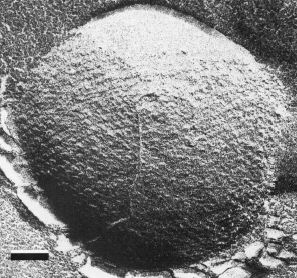Thermococcus barophilus
Classification
Archaea; Phylum: Euryarchaeota; Class: Thermococci; Order: Thermococcales; Family: Thermococcaceae
Species
|
NCBI: Taxonomy |
Thermococcus barophilus
Description and Significance
Thermococcus barophilus is a hyperthermophilic, anaerobic, mixed heterotrophic, and carboxydotrophic euryarchaeon first isolated in 1993 [1]. Classified as extremely thermophilic, Thermococcus barophilus was originally found in the chimney wall of “Snakebite” a Mid-Atlantic hydrothermal vent. This location was at a depth of 3550 meters. Specific strains of T. barophilus have optimal growth conditions of 40 MPa and 85℃ but are able to grow at pressures ranging from 0.1 to 85 MPa and temperatures ranging from 48℃ to 100℃ [2].
Genome Structure
Thermococcus barophilus has a circular chromosome with 2,020,078 bp and a circular plasmid, named pTBMP1, with 54,159 bp. There is a G + C content average between 38.3% and 41.7% [3]. There is anywhere between 7 and 26 DNA repeats within the genome from 4 different CRISPR loci [3]. The entire annotated genome of T. barophilus is available in GenBank with the accession number CP002372. The plasmid is also available in GenBank with the number CP002373.
Cell Structure, Metabolism and Life Cycle
The size of these cells generally fall between 0.8 and 2.0 micrometers though some can be as large as 5 micrometers with a slightly irregular cocci shape and live as a form of plankton. The cell envelope is covered with an S-layer lattice and ether lipids are found within the cell, a key indicator that this species belongs to archaea [1].
This microbe is an obligate anaerobic chemo-organotroph. It is a sulfur-metabolizer although sulfer is not required for it to grow; it enhances growth. T. barophilus is a heterotrophic and can grow in the presence of yeast extract and peptone. The microbe also tends to grow the best when it uses ammonium chloride as its source of nitrogen [1]. Replication occurs by constriction.
Ecology and Pathogenesis
T. barophilus can be found in the chimneys of deep sea hydrothermal vents such as the “Snakepit” in the mid-Atlantic ocean. It lives in conditions of high pressure, high temperatures, and high concentrations of carbon monoxide. This microbe can survive under varying pressures, yet the growth rate doubles under high pressure [1]. T. barophilus was one of the first barophiles isolated below a depth of 3000 meters. No symbiosis has been documented for this species mostly due to a lack in ability to grow these species for long periods of time and living in harsh conditions. Research does not suggest that T. barophilus is pathogenic. It is, however, susceptible to a few antibiotics such as chloramphenicol and rifampicin [1].
References
NCBI (2013): "Thermococcus barophilus overview" . European Nucleotide Archive.
1 Marteinsson, V. T., Birrien, J., Reysenbach, A., Vernet, M., Marie, D., Gambacorta, A., Messner, P., Sleytr, U.B., and Prieur, D. “Thermococcus barophilus sp. nov., a new barophilic and hyperthermophilic archaeon isolated under high hydrostatic pressure from a deep-sea hydrothermal vent” International Journal of Systematic and Evolutionary Microbiology. April 1999 vol. 49 no. 2 351-359
2 Thiel, A., Michoud, G., Moalic, Y., Flament, D., and Jebbar, M. “Genetic Manipulations of the Hyperthermophilic Piezophilic Archaeon Thermococcus barophilus” Applied and Environmental Microbiology April. 2014 vol. 80 no. 7 2299-2306
3 Vannier, P., Marteinsson, V. T., Fridjonsson, O.H., Oger, P., and Jebbar, M.“Complete Genome Sequence of the Hyperthermophilic, Piezophilic, Heterotrophic, and Carboxydotrophic Archaeon Thermococcus barophilus MP” Journal of Bacteriololgy March 2011 vol. 193 no. 6 1481-1482
Author
Page authored by Annie Hagerty and Maddison Hite, students of Prof. Jay Lennon at IndianaUniversity.


